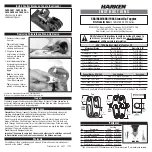
Chapter 5
Setup and Configuration
RUGGEDCOM ROX II
User Guide
554
Managing Dynamic Multicast Routing
5. Click
Exit Transaction
or continue making changes.
Section 5.24
Managing Dynamic Multicast Routing
The PIM-SM feature is used for Dynamic Multicast Routing. PIM-SM stands for Protocol Independent Multicast -
Sparse Mode. It is a dynamic multicast routing protocol that can dynamically prune and maintain multicast routes.
PIM relies on the router's unicast routing table for its capabilities and does not rely on any specific method for
learning routes, therefore it is "Protocol Independent".
The following terms are used in PIM-SM:
•
Rendezvous Point
The rendezvous point (RP) is a destination in the network (one of the routers), where all multicast traffic is
first registered. Whenever a PIM router receives a multicast stream, the source and the multicast address are
registered with the rendezvous point.
•
Boot Strap Router
A PIM-SM boot strap router (BSR) is a router that announces the location of the rendezvous point to all other
PIM routers on the network.
•
Designated Router
A designated router (DR) is a router directly attached to a multicast host or device. The router with the highest
IP address usually becomes the designated router.
•
Shared Tree
The shared tree, also known as the RP-Tree, is a traffic distribution tree which begins from the rendezvous
point. The rendezvous point will forward the particular multicast group traffic through this tree whenever there
are subscribers for a given multicast flow. Note that the shared tree is on a per-group basis. This means
that the shared tree for one group could be different than the shared tree for another on the same network
depending on the distribution of the multicast traffic subscribers.
•
Shortest Path Tree
The shortest path tree (SPT) is a traffic distribution tree which begins at the source of the multicast traffic or
rather the router nearest to the source. The shortest path tree is activated whenever there is a shorter path
between the source and the receiver. The shortest path tree can only be triggered by the rendezvous point or
the router connected directly to the subscriber.
•
Internet Group Management Protocol
Internet Group Management Protocol (IGMP) is the protocol used by hosts and routers to join and leave
multicast groups. Routers will send IGMP queries at regular intervals querying whether there are any hosts
interested in IP multicast traffic. Whenever an attached host is interested in receiving traffic for a certain
group, it will send an IGMP report message expressing its interest. The router will then a) propagate this Join
message to another router and b) send the relevant traffic to the segment to which the host is attached.
The following sections describe how to configure and manage PIM-SM:
•
Section 5.24.1, “PIM-SM Concepts”
•
Section 5.24.2, “Configuring PIM-SM”
•
Section 5.24.3, “Viewing a List of PIM-SM Interfaces”
•
Section 5.24.4, “Enabling/Disabling a PIM-SM Interface”
•
Содержание RUGGEDCOM RX1510
Страница 32: ...RUGGEDCOM ROX II User Guide Preface Customer Support xxxii ...
Страница 44: ...RUGGEDCOM ROX II User Guide Chapter 1 Introduction User Permissions 12 ...
Страница 62: ...RUGGEDCOM ROX II User Guide Chapter 2 Using ROX II Using the Command Line Interface 30 ...
Страница 268: ...RUGGEDCOM ROX II User Guide Chapter 4 System Administration Deleting a Scheduled Job 236 ...
Страница 852: ...RUGGEDCOM ROX II User Guide Chapter 5 Setup and Configuration Enabling Disabling an LDP Interface 820 ...
















































